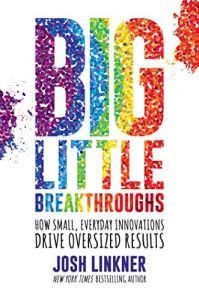Join getAbstract to access the summary!

Join getAbstract to access the summary!
Josh Linkner
Big Little Breakthroughs
How Small, Everyday Innovations Drive Oversized Results
Post Hill, 2021
What's inside?
You can learn to be creative and to innovate.
Recommendation
Groundbreaking innovations may seem like bolts of lightning, but in fact, most world-changing ideas don’t occur in one fell swoop. They are the culmination of a series of far smaller wins. In this engaging manual, best-selling innovation expert Josh Linkner aims to demystify the creative process and show how any person from any walk of life, can learn to become a creativity powerhouse. To that end, he offers up an eight-part framework for innovative thinking and problem-solving, using stories of successful innovators to illustrate these tactics in practice. Whether you are already a successful innovator looking to improve your skill or someone with good ideas who doesn’t know how to start, Linkner’s methods will help set your imagination free.
Summary
About the Author
Chairman and co-founder of Platypus Labs Josh Linkner also wrote the New York Times bestsellers Disciplined Dreaming and The Road to Reinvention.



















Comment on this summary